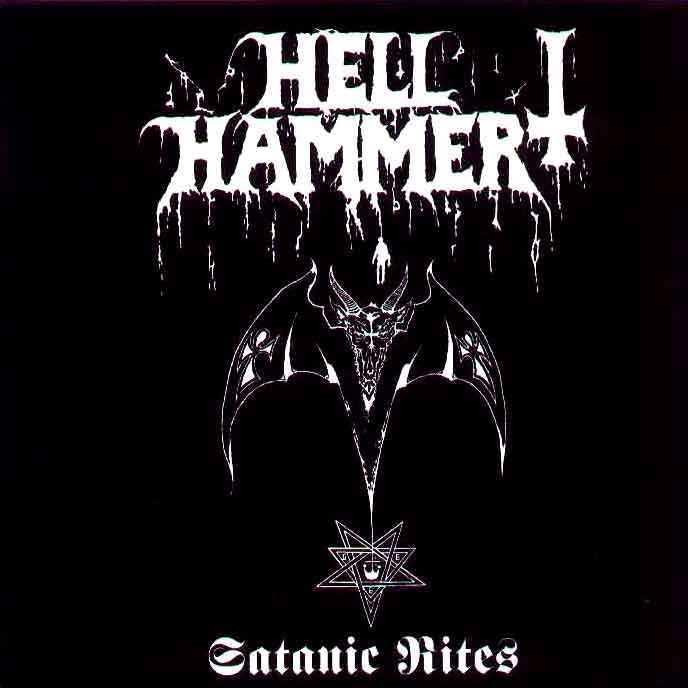
Form and Function
Musical innovation does not spawn independently. Most of the progressions in underground metal have taken stylistic influence from more accessible genres and within those aural parameters created a new foundational narrative to divorce the context from the aesthetics it had previously used as a guideline. This approach allows for a less jarring immersion into a musical journey while at the same time utilizing tropes of superficial familiarity to manipulate the audience into being subjugated to an indirect path towards the artistic catharsis of unique expression that is the spiritual negative of the aesthetics used. On Satanic Rites, we can observe how Hellhammer has utilized the foundation of punk rock to shape their sound while introducing a unique tonality and dynamic scope to flesh out the beginnings of a new musical genre.
The initial encounter with the band’s sound is limited to one speed and 5th chord shapes (power chords) that to the common listener will not be far removed from punk rock. The arrangements are similarly lifted from that genre as the narrative relationships are limited to little more than two phrases. What is unique, is that the “chorus” element of the song, or the anthemic phrase that bears the most dynamic catharsis, appears instrumentally, as in the track ‘Messiah’. At this point in history, the rebellion present in the initial phase of punk had become innocuous and fashionable, and to represent a true sense of rebellion, the underground had to go further. Removing the vocals from the phrasal focus of the song develops a true rebellion from songwriting familiarity, and is only a hint at where the band would further manipulate the audience as the album continues. To further cement the divorce from the punk rock foundation, this particular phrase, while comprised of the 5th chords of punk rock, shifts chromatically to provide a climax that is cathartic in terms of momentum but aloof with regard to tonality.
It isn’t until the third track, ‘Buried and Forgotten’, that the band completes its functional divorce from punk altogether. Tempos slow to a doomy crawl and where a somewhat predictable tonality had been the bedrock of the music overall, riffs now shift from minor to major keys with obvious disregard to familiar phrasing. Phrasal length has now abandoned strict four-or-eight beat counts, slow melodies with single notes taking up whole measures emerge. And where drumming had previously been limited to a Motörheadesque continuous drive, percussive voids are present to allow full melodies to retain focus and accents are used to provide importance to specific notes within each phrase. Certain notes are bent out of pitch with little rhythm underneath them to force the audience into a lull of uncertainty and anticipation. As this journey into foreign musical territory develops, the vocals shift from anthemic punk to satanic oratory. The audience has now been fully bait-and-switched.
As the record progresses, the band takes its established foundation and shifts aesthetics from punk rock familiarity to its own voicings repeatedly while occasionally adding new elements, such as the bare abstractions of ‘Triumph of Death’. The latter allow the punk verses that bookend them to force a duality that was never hinted at in the monochromatic ‘Messiah’ and the erratic tempo shifts of ‘Eurynomos’. These, because they are centered around power chords, allow for a full manipulation of the listener as an aesthetic familiarity is approached but contextually nearly derailed.
Brief respites in momentum are provided by the longer held notes over percussive voids, as shown in ‘Revelations of Doom/. Conversely, during the two-step rhythmic anchorings of ‘Reaper’, which showcase a flair of punk attitude that functions purely transitionally in-between doomy segments. While almost all of the songs are limited to very few phrases, the dynamics present in the tonality and occasional musical flourishes versus the continued percussive momentum cause the two dimensions to mean more in juxtaposition than their isolated elements would allow.
By the album’s end, the listener has become fully immersed in the conflict that the ambiguity of chromatic phrasing provides when coupled with the impetus of punk rock drumming. Despite this familiar foundation, an inversion of punk ethics is fully realized as a result of the lack of focus on melodic vocal, and the anticipation of the impending catharsis of chorus that a bridge provides in song arrangements. It is in this way that a burgeoning path towards an uncharted musical territory is achieved. The outro of the record completes the journey as all sense of musical familiarity is cast aside in favor of a devolving of musical principles to allow just a blasphemic marrow to flourish. Few bands have done with a familiar musical framework what Hellhammer has done on Satanic Rites, and this exposes the meaning of true artistry within not just underground metal, but musical expression as a whole.
Tags: Black Metal, death metal, hellhammer, satanic rites, the craft of metal

